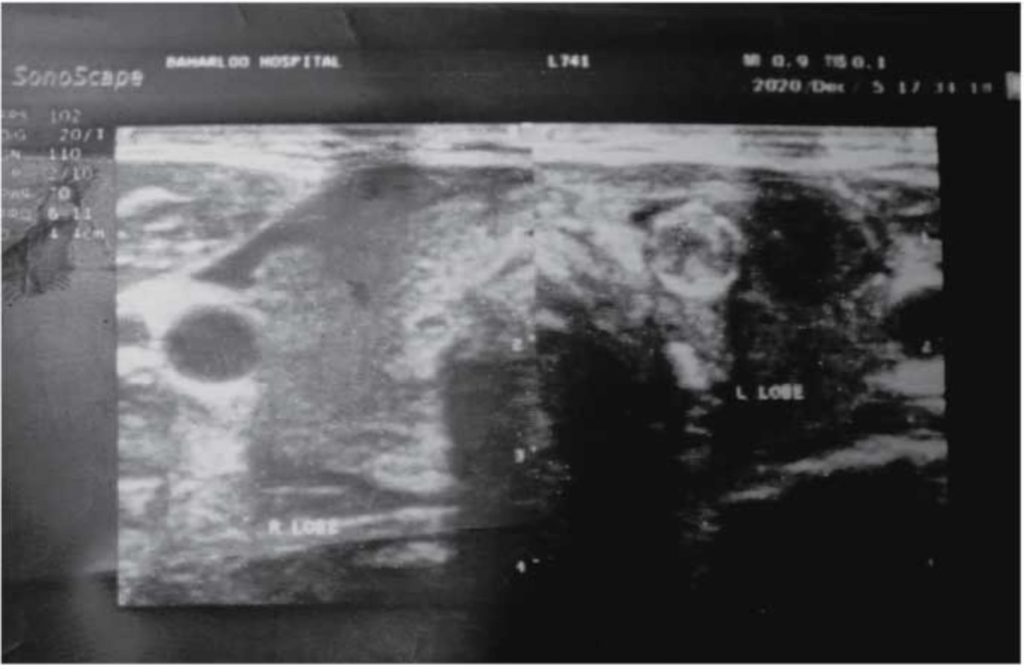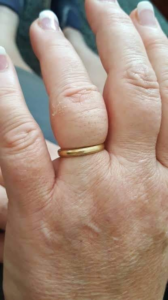Introduction
Understanding the diverse impacts of SARS-CoV-2, the virus responsible for the global COVID-19 pandemic, on various body systems is vital in the world of medical science. The virus, primarily affecting the respiratory system, has also demonstrated significant influence on other organs, including the thyroid gland. This blog post will focus on a specific thyroid condition – Subacute Thyroiditis (SAT), which has been recently associated with SARS-CoV-2 infection. SAT, also known as de Quervain’s thyroiditis, is an inflammatory thyroid disease characterized by neck pain, fever, and an elevated metabolic rate. It is typically self-limiting and often follows an upper respiratory tract infection.
Recent research and clinical observations have shed light on a potential link between SARS-CoV-2 and SAT. This relationship, although unexpected, suggests that SARS-CoV-2 can trigger an immune response resulting in thyroid inflammation, thereby leading to SAT. While our knowledge about this association is still unfolding, it’s crucial for medical professionals and students alike to understand the potential implications of this connection.
As we delve deeper into this case study, we will explore the journey of a patient diagnosed with SARS-CoV-2 who subsequently developed SAT. This case offers an opportunity to understand how this virus impacts the thyroid gland and how it may alter patient management strategies. Moreover, we will discuss diagnostic criteria proposed by Stasiak and Lewinski for COVID-19-induced SAT and use these parameters to evaluate our patient’s condition.
Case Presentation
This case revolves around a 55-year-old man who resides in Mardan, KPK. He presented to our clinic with symptoms of diffuse neck pain extending to the jaw, severe and frequent coughing, and hot flashes. Upon examination, his thyroid gland appeared tender to touch; however, his vital signs were within the normal range, indicating no immediate life-threatening condition.
A significant point in the patient’s medical history was his recent battle with COVID-19. Approximately 15 days prior to his presentation to our clinic, he had tested positive for SARS-CoV-2, as confirmed by a Polymerase Chain Reaction (PCR) test. To treat his COVID-19 symptoms, he had been prescribed favipiravir and Dexamethasone, receiving 8 mg of the latter daily for three consecutive days. Favipiravir is an antiviral drug used for treating influenza, and it has shown some promise against SARS-CoV-2. Dexamethasone, on the other hand, is a corticosteroid that has been used to manage the inflammatory response triggered by the virus.
Our patient’s primary symptoms – neck pain, coughing, and hot flashes – were initially non-specific, meaning they could be linked to various conditions, including his recent COVID-19 infection. However, the pain in the neck radiating to the jaw and the tenderness of the thyroid gland observed during the clinical examination raised suspicions towards a possible thyroid-related condition.
It is also noteworthy that the patient denied any history of thyroid diseases or the use of any long-term medication, making his case more intriguing. The combination of the patient’s symptoms, recent COVID-19 infection, and his negative history for thyroid diseases led us to investigate his thyroid function. Understanding the patient’s symptoms in the context of his recent SARS-CoV-2 infection made it imperative to explore the less-known impacts of this virus on the endocrine system, particularly the thyroid gland.
Diagnostic Approach
Given the symptoms and recent medical history, we decided to delve deeper into the patient’s thyroid function. For this purpose, we ordered a Thyroid Function Test (TFT), a panel of blood tests used to evaluate how effectively the thyroid gland is working. The TFT measures levels of thyroid-stimulating hormone (TSH), triiodothyronine (T3), and thyroxine (T4). These hormones are essential for regulating the body’s metabolism and energy production. In our patient’s case, the TFT revealed elevated levels of T3 and T4 and a decreased TSH level, a typical biochemical profile of hyperthyroidism, which is often seen in the initial stages of SAT.

In addition to the TFT, a Complete Blood Count (CBC) was also conducted. The CBC is a frequently ordered blood test that gives important information about the kinds and numbers of cells in the blood, especially red blood cells, white blood cells, and platelets. It’s a crucial diagnostic tool for determining a patient’s general health status and detecting a variety of disorders including infections, anemia, and leukemia. Our patient’s CBC results showed an elevated white blood cell count (WBC: 10.4 × 10^9/l), a lower red blood cell count (RBC: 3.95 × 10^12/l) and hemoglobin level (Hb: 11.9 g/dL), and an increased platelet count (PLT: 432 × 10^9/l). The lymphocyte rate was slightly low (19%). These results suggested an ongoing inflammatory or infection process in the body.
To confirm our suspicions about an inflammatory process, we also analyzed the patient’s inflammatory markers. Erythrocyte sedimentation rate (ESR) and C-reactive protein (CRP) are two commonly used tests to assess systemic inflammation. In our patient, the ESR was significantly high (121 mm/h), far above the normal range of up to 20 mm/h. The CRP titer was also elevated (92.6 mg/l), where a normal value would be less than 10 mg/l. These elevated inflammatory markers provided another piece of evidence supporting an ongoing inflammatory condition, likely related to the thyroid gland.
The next step in the diagnostic process was a thyroid ultrasound, which provides images of the thyroid gland and can detect changes in its size, shape, and texture. It is particularly helpful in diagnosing thyroid diseases, such as goiter, nodules, or cancer. Our patient’s thyroid ultrasound revealed a mild diffuse goiter, which means an overall enlargement of the thyroid gland. Interestingly, the ultrasound also showed a focal and ill-defined hypoechoic area, which is a typical finding in SAT.

Through a detailed diagnostic approach, we were able to gather significant information about our patient’s condition. The clinical examination, coupled with TFT, CBC, inflammatory markers, and a thyroid ultrasound, pointed towards a possible diagnosis of SAT. However, given the patient’s recent SARS-CoV-2 infection, we also had to consider whether this SAT could have been triggered by the virus. This led us to evaluate the patient’s condition against Stasiak and Lewinski’s diagnostic criteria for COVID-19-induced SAT, based on the novel characteristics of SAT associated with SARS-CoV-2. By comparing these criteria with our patient’s clinical findings, we hoped to reach a definitive diagnosis.
Diagnosis and Evaluation
Our patient’s condition, when viewed in the context of his recent SARS-CoV-2 infection, presented an intriguing case. The symptomatology and results from various tests were suggestive of SAT, a condition that has been recently associated with COVID-19. Hence, we considered the possibility of this being a case of COVID-19-induced SAT, a novel clinical entity that is still being researched extensively.
One of the challenges in diagnosing SAT in the context of a recent SARS-CoV-2 infection is that there is no universally accepted diagnostic criteria specifically for this variant of SAT. However, in a recent work, Stasiak and Lewinski proposed new diagnostic criteria for COVID-19-induced SAT. Their proposal was based on unique characteristics of SAT triggered by SARS-CoV-2 and included parameters like temporal relationship of SAT with COVID-19, absence of other precipitating factors, ultrasound findings typical of SAT, and more.
In our patient, we compared his clinical findings with these proposed criteria. This comparison was essential because it could provide a framework for understanding how SARS-CoV-2 may trigger SAT and guide us in effectively managing this condition. It was observed that our patient met these criteria, thereby strengthening the likelihood of his SAT being induced by his recent SARS-CoV-2 infection.
The diagnosis was further confirmed by the clinical progression of the disease. The patient presented symptoms such as pain in the front of the neck while speaking, despite receiving initial treatment with aspirin. This observation is consistent with some reports of COVID-19-induced SAT patients who experienced a more extended and severe clinical course than typical SAT patients.
In conclusion, the alignment of the patient’s symptoms, laboratory findings, ultrasound results, and recent COVID-19 diagnosis with the proposed criteria of COVID-19-induced SAT led to the diagnosis of SAT triggered by SARS-CoV-2 in this patient. The diagnosis underscores the importance of considering this novel pathophysiological link in the differential diagnosis of patients with recent SARS-CoV-2 infection presenting with symptoms of SAT.
Treatment and Management
Upon diagnosing the patient with COVID-19-induced Subacute Thyroiditis (SAT), we embarked on the patient’s treatment course. As SAT is primarily an inflammatory condition, the cornerstone of treatment is providing relief from inflammation and associated symptoms.
We initiated treatment using aspirin, a non-steroidal anti-inflammatory drug (NSAID) that is frequently used in treating SAT. NSAIDs not only help reduce inflammation but also provide analgesia, thus relieving the patient’s pain. Additionally, aspirin possesses anti-pyretic properties that can help manage the patient’s hot flashes.
However, our treatment approach had to be dynamic and responsive to the patient’s condition. After 10 days of aspirin therapy, the patient showed no significant improvement. He continued to experience pain in the front of his neck while speaking, indicating persistent inflammation and discomfort. This led us to reevaluate the treatment strategy.
As a result, we introduced prednisolone, a corticosteroid, at a dose of 25 mg/day. Corticosteroids like prednisolone are potent anti-inflammatory and immunosuppressive agents. They are often employed in treating SAT when patients fail to respond to NSAIDs or in cases with severe symptoms. Their use, however, requires careful consideration due to potential side effects, including fluid retention, hypertension, mood changes, and increased risk of infections. Therefore, regular follow-up and monitoring of patients receiving corticosteroids is necessary.
In the case of our patient, prednisolone proved to be successful. Three weeks into the prednisolone treatment, his symptoms resolved. There was no more pain in the neck, and the patient reported feeling significantly better. In accordance with the improvement in his condition, repeated thyroid function tests were conducted, which showed that his T3, T4, and TSH levels had returned to their normal ranges. This was an encouraging outcome, suggesting that the inflammation in the thyroid gland had subsided and the gland was returning to its normal functional state.

This case showcases the importance of tailored treatment strategies based on patient response. The initial lack of response to aspirin warranted a switch to a more potent anti-inflammatory agent, which led to the resolution of symptoms. Furthermore, it emphasizes the potential severity of COVID-19-induced SAT, as patients may require more potent treatments such as corticosteroids.
It is also worth noting that management of SAT is not limited to pharmacological treatment. Patients should be advised to rest, maintain a balanced diet, and have regular follow-ups to monitor their condition. Furthermore, in the case of COVID-19-induced SAT, it is necessary to consider the patient’s overall health and any lingering effects of the SARS-CoV-2 infection. Therefore, a comprehensive, patient-centered approach is crucial in managing this condition effectively.
Discussion
This case presents a rare but increasingly recognized association between SARS-CoV-2 and Subacute Thyroiditis (SAT). It underscores the importance of acknowledging the varied impacts of SARS-CoV-2 on different body systems, beyond its well-known respiratory manifestations. The relationship between SARS-CoV-2 and SAT signifies that the virus could trigger an immune response leading to thyroid inflammation and dysfunction, although the exact mechanisms remain to be fully understood.
This case also highlights the significance of tailored treatment strategies based on the patient’s response. Our patient did not respond to the first-line treatment with aspirin, an NSAID commonly used in SAT management. However, the switch to a corticosteroid, prednisolone, led to the resolution of symptoms and normalization of thyroid function. This suggests that patients with COVID-19-induced SAT might have a more severe clinical course requiring potent anti-inflammatory treatment.
Moreover, our current understanding of SARS-CoV-2’s effects on thyroid function is largely based on anecdotal reports and observational studies. As such, larger scale, systematic studies are needed to explore this association and its implications for patient management more thoroughly. Furthermore, the criteria for diagnosing COVID-19-induced SAT, as proposed by Stasiak and Lewinski, were useful in this case. However, they still need validation from further research before they can be widely adopted.
As our knowledge about SARS-CoV-2 continues to evolve, cases like this remind us of the multifaceted nature of this virus and its broad-reaching effects on human health. They serve as a call to remain vigilant and adaptable in our approach to patient management in the era of COVID-19.
Conclusion
In sum, this case provides valuable insights into a relatively unexplored association between SARS-CoV-2 and Subacute Thyroiditis (SAT). The alignment of the patient’s symptoms, laboratory findings, ultrasound results, and recent COVID-19 diagnosis with the proposed criteria for COVID-19-induced SAT confirmed this association and underlined the broad clinical spectrum of SARS-CoV-2.
Our patient’s successful treatment with prednisolone, following an unresponsive course with aspirin, underscores the need for individualized management strategies in these cases. This need becomes even more crucial considering the potential severity of COVID-19-induced SAT, as patients might require more potent treatments like corticosteroids.
This case serves as a reminder of the manifold ways that SARS-CoV-2 can affect the body, beyond its well-known respiratory impacts. It calls for heightened awareness among clinicians about the possibility of SAT in patients with recent COVID-19, especially when presenting with symptoms like neck pain and systemic symptoms of inflammation.
However, it is crucial to stress that further research is necessary to fully understand the pathophysiology of COVID-19-induced SAT. We need more evidence to validate and refine the diagnostic criteria and to guide management. Large-scale studies are required to determine the prevalence of this condition among COVID-19 patients and to assess the long-term implications of this association. Ultimately, as we continue to navigate through the challenges posed by the COVID-19 pandemic, a comprehensive, adaptable, and patient-centered approach remains at the heart of effective clinical care.
References:
- Brancatella A, Ricci D, Viola N, Sgrò D, Santini F, Latrofa F. Subacute Thyroiditis After Sars-COV-2 Infection. The Journal of Clinical Endocrinology & Metabolism. 2020. Link
- Asfuroglu Kalkan E, Ates I. A Case of Subacute Thyroiditis Associated with Covid-19 Infection. Journal of Endocrinological Investigation. 2020. Link
- Desailloud R, Hober D. Viruses and thyroiditis: an update. Virology Journal. 2009. Link
About the Author
Dr. Shahid Irfan is a distinguished digital creator and medical professional specializing in Endocrinology, Dermatology, and Diabetology. Currently practicing at Marham, his knowledge and expertise span a wide array of medical conditions, providing a comprehensive perspective in patient management.
In addition to his practice at Marham, Dr. Irfan is a respected Consultant Endocrinologist at the esteemed Chiang Mai Ram Hospital in Thailand. Here, he employs his robust knowledge and expertise to provide exceptional patient care, demonstrating his commitment to the field of Endocrinology.
Originally from Swat, Pakistan, Dr. Irfan now resides in Chiang Mai, Thailand. His journey traversing different healthcare landscapes has enriched his medical practice, giving him unique international exposure that he brings into his patient care approach.
Dr. Irfan’s passion extends beyond clinical practice. He is devoted to empowering patients and the broader public by making complex medical knowledge more accessible. His detailed case studies, like this one, are testament to his commitment to enhancing understanding of various health conditions.
In this case study, Dr. Irfan draws from his diverse medical expertise and international experience to explore the complexities of a pediatric case, providing invaluable insights for both practicing medical professionals and students.



